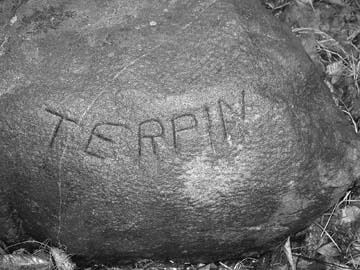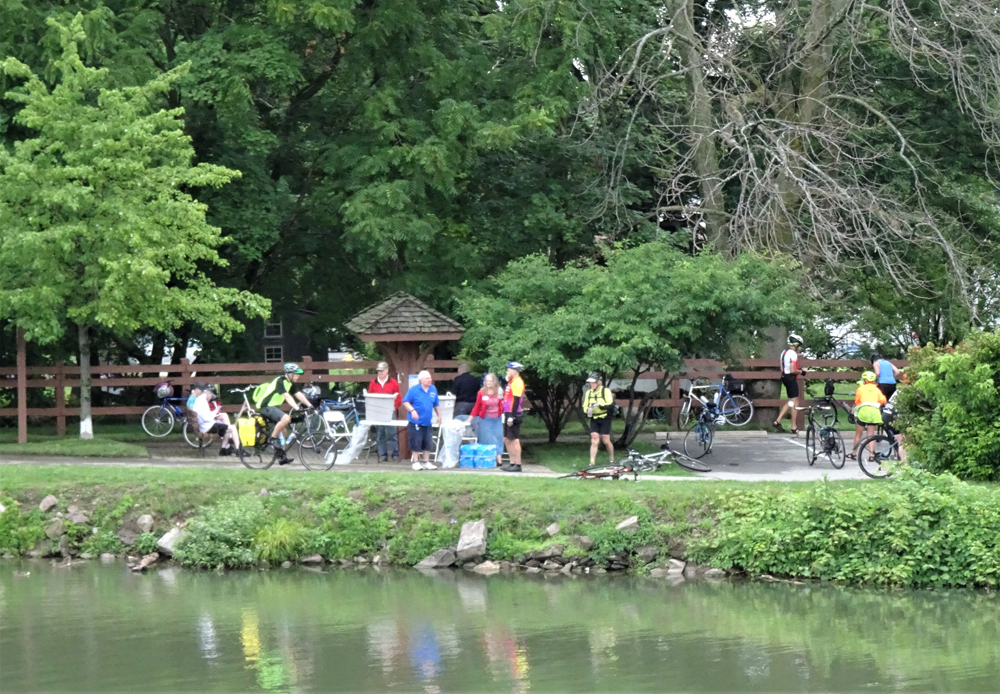Hamlin CCC/POW Camp: Terpin Rock Mystery – solved!
by Ed Evans
 The letters carved into the Terpin Rock were digitally enhanced for printing by Westside News Inc. Photo provided by Ed Evans.A couple of long-time park employees got to talking to Jay, the new Hamlin Beach State Park manager, about a rather large, stray boulder hidden in dense overgrowth behind the new park administration building. They told Jay that in the old days, when they were kids, they used to play around the rock. Back then, the park still mowed that area, carefully maintaining little picnic groves and a rolling lawn connecting the Area #2 parking lot to the refreshment stand at Area #3. The rolling lawn and fireplaces were part of the original plan for the park but that rock stood out like a sore thumb.
The letters carved into the Terpin Rock were digitally enhanced for printing by Westside News Inc. Photo provided by Ed Evans.A couple of long-time park employees got to talking to Jay, the new Hamlin Beach State Park manager, about a rather large, stray boulder hidden in dense overgrowth behind the new park administration building. They told Jay that in the old days, when they were kids, they used to play around the rock. Back then, the park still mowed that area, carefully maintaining little picnic groves and a rolling lawn connecting the Area #2 parking lot to the refreshment stand at Area #3. The rolling lawn and fireplaces were part of the original plan for the park but that rock stood out like a sore thumb.
It was the only big rock as far as the eye could see, and the top was chiseled and shaped to look like one of those metal tractor seats of yore. The west side of the rock had been painstakingly faced using a hammer and chisel and then “TERPIN” was chiseled across the front in letters that are nearly two inches tall.
Those 1950s-60s kids wondered about the rock and helped to spread some old Indian fable about some chief somehow or other sitting on the rock to give it its “seat” shape. Sometime during that era, the park stopped maintaining that area and thick brush and tall, untended trees soon had people avoiding that entire area. Eventually, the rock all but disappeared from view and most of the kids who used to play around it, and on it, grew up and moved away.
It was two of those kids who didn’t move away and went on to become park employees who showed Jay where the rock still sits. Jay was so impressed that he showed it to me. He thought it might be a crude grave marker from back in the days when the area was first being settled. Or “it might be marking the grave of a pet.” Perhaps “it had something to do with the CCC boys who built the park back in the 1930s.”
I immediately became fascinated with the rock. I told Jay we had to clear the area of brush right away so people could easily find the rock. We could use it to promote the park. “Oh no,” says Jay. “First I’ve got to be sure that it’s not a grave. I could get in big trouble.” Instead, he asked me to tell the Town Historian about the rock and have the records checked to be sure someone named Terpin was not buried there.
I called Mary Smith, Hamlin Historian Emeritus, and mulled the mystery over in my own head for a couple of days. I was pretty sure it wasn’t a grave for a person. There was no listing in any of the local phone books for a Terpin and only a few listings with variations in the spelling. Perhaps someone had a dog they called Turpentine, and shortened it to Tur-pen. When the dog died they phonetically chiseled Terpin into the rock not really knowing or caring how “turpentine” is really spelled.
Then I got a hair brained idea. I had one and only one CCC group photo with names accompanying it – the one with Jimmy Giancaterin in it. There were 149 CCC guys in the photo and the photo was dated August 1938. Just maybe…. Nah. What are the odds? Not very likely. But, what the heck. I went out to my CCC collection, found the photo and turned it over. There was a Chester Terpin listed there. I couldn’t pick him out of the crowd, of course, but he was somewhere in that picture.
Then it struck me: In all of that cement work in that huge park the CCC boys built, no one, no one, no one ever put so much as their initials into any wet cement anywhere. In the CCC campsite itself, a half mile away – and we have uncovered and examined every inch of the camp’s 8 acres – there exists only one set of initials, tiny, and consisting of only two letters, in an obscure corner of what used to be a garage. What possessed this young man to carve his whole name on a rock? And why was it left there in plain sight? And why has no mention of it ever been made? Where did the rock come from? What kind of guy was this Chester Terpin?
Among the stuff Jimmy Giancaterin unknowingly left me (diaries, 140 letters, etc.) there are a few rare “Hamlin Specials” – the Hamlin CCC camp weekly newspaper – printed in 1938. I began reading them again. In the last April issue for 1938 I found an article listing the new enlistees just entering the camp. Chester Terpin is mentioned in the second paragraph and it says he came from Buffalo.
Acting on that clue, my wife found some information on Chester Terpin on the Internet. It listed his parents, his siblings, and gave some information about his military record. A great start. Then my wife got me addresses for eight Terpins in the Buffalo, Southern Tier area and I wrote a letter about the rock and sent a copy to each of the eight Terpins. I asked for any information on a “Chester” Terpin. I enclosed a CCC postcard from Mary Smith’s historical Hamlin collection, a self addressed stamped envelope, and my business card with all kinds of contact information. In less than a week I got an answer back in a big, 8-1/2 x 11 envelope.
One of my letters had been passed on to Patricia Butler, Chester Terpin’s daughter. And she wrote me a nice letter about her Dad, Chester (Chet) Terpin. And she enclosed a couple of pictures of him on plain paper that were scanned on her home computer.
I have since gotten two emails from Patricia “Terpin” Butler with more interesting stuff about her father, the rock carver. He was not an Indian chief. He was a very shy 18 year old boy, born to a husband and wife who had immigrated from Poland. He had a fifth grade education when he quit school and went to work to help support his father’s family of seven kids. In 1938, he enlisted in the CCC to learn a trade and earn some money. It was his severe acne that had made him shy but the hearty CCC diet soon cured the acne. And the CCC changed the rest of his life, too.
According to his daughter, he spent a lot of his adult life telling his kids about his CCC experience. She says he learned carpentry and masonry and cooking in the CCC. His “artificial ice cream” concoction was a family favorite and most certainly was mastered in the CCC camp. All of his family’s vacations his entire life were spent camping in New York State Parks that had a CCC connection. He hit every one of them. He was repeating that quest with his grandchildren when he died at 59 in 1978.
I sent a poor copy of my 1938 group CCC photo to Patricia Butler and she picked her Dad out of the 149 blurry faces immediately. Tears came to her husband’s eyes as she pointed to Chester Terpin, the 5’5’’ shy guy who gave us that wonderful rock we are just now starting to talk about. Thanks to Jay Bailey, his staff, Patricia Butler, and, of course, Chester Terpin, that rock is now a local monument to the CCC program America still owes so much.



